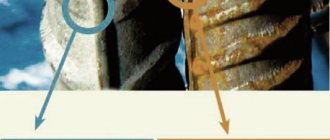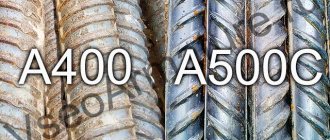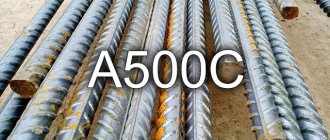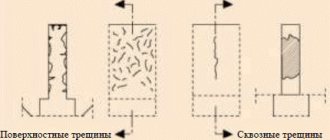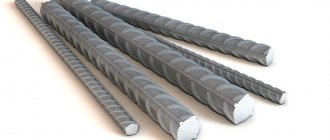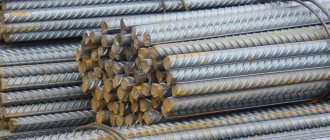When carrying out repair work, situations arise when it is necessary to place fastening elements on the wall, but there is a possibility that the drill will rest against the laid reinforcement. We will tell you in this article how to find reinforcement in a concrete wall using electronic devices, the difficulties that arise when drilling walls and how to solve them.
Using devices to find hidden fittings
Why do you need to look for reinforcement in concrete?
When carrying out construction and repair work and maintenance of a building, it is imperative to know where the fittings are located. For these purposes, a reinforcement detector in concrete is used. It establishes exactly where the reinforcement goes, its diameter, as well as the thickness of the concrete layer. This need arises because when a drilling or other tool collides with reinforcement, not only the equipment is damaged. This can damage the structure of the reinforcement or, in the case of minor damage to the rod, lead to subsequent corrosion of the reinforced concrete panel.
According to GOST, searching for reinforcement in concrete structures and measuring the thickness of the protective layer is carried out using the magnetic method. How to find the threads for the metal rods depends on the thickness of the concrete layer. After all, you can use both an ordinary powerful magnet and hypersensitive devices. But in accordance with regulatory requirements, these parameters are set only by certified devices that are included in the State Register of Measuring Instruments.
Using this method, the subtleties of the protective layer are established, underfilling concrete during construction of the structure, the location of the reinforcement, and its approximate diameter. This method of control allows you to complete the task without violating the integrity of the structure.
To carry out the task, the controlled plane is scanned. As a result, all the necessary parameters are displayed. To clarify the indicators about the diameter of the rods, control areas are opened. Reinforcement installation technique:
- scan the surface using a magnetic or geophysical method;
- determine the location of the reinforced mesh on the surface, the thickness of the protective layer and the location of the rods;
- They open control areas and help determine the accuracy of these devices.
Procedure for checking reinforcement
Step 1. Scanning the surface of the reinforced concrete structure using the device.
Measuring the protective layer of concrete. Step 2. Identification of detected elements and applying them in a grid form to the concrete surface.
Step 3. If it is necessary to directly measure the diameter of the reinforcement, then control areas are determined and, if necessary, opening is performed on them.
Step 4. Reproduction and decoding of the examination results in the form of radargrams, etc. Drawing up reports, checking the reinforcement estimate for accuracy and other work.
The results of inspection of the reinforcement of reinforced concrete structures are accurate and reliable. With the help of experts, you can literally look inside a concrete beam, slab, or foundation block.
Search devices
The principle of operation of such devices is to register changes in the electromagnetic field when colliding with metal objects.
Elcometer P120
One of the easiest and fastest devices to use. It establishes the location of the rods, the direction, and the thickness of the protective concrete layer. The size of the search head of the device is 10 cm. It notifies you of search results using a loud sound signal, as well as data on the scale. Data is not distorted when working near large metal objects.
The sensitivity of the Elcometer P120 makes it possible to quickly and accurately determine the vertical and horizontal direction of reinforced rods. After detecting the reinforcement, it is necessary to move the device in the direction of the rod to determine the maximum minimum signal level. The minimum signal means that the fittings pass at an angle of 900 to the handle of the device. There is also a headphone jack, which allows you to work in crowded and noisy places.
- detectable reinforcement diameter 0.8-3.2 cm;
- measured concrete layer 1.2 - 1.6 cm.
Return to contents
Elcometer P100
Despite the low price, this device is lightweight, reliable and accurately determines the required parameters (reinforced rods, pipes, stainless steel ties, etc.). The search head size is 10 cm. It notifies you of scanning results using a loud sound signal. Elcometer P100 allows you to set the direction of the valve.
PROFOSCOPE
- linear indicator, digital data and sound signal for searching reinforced rods;
- accuracy in determining the thickness of the concrete layer;
- small size;
- the sensor's protective rods slide easily along the plane being tested;
- built-in battery with charger.
- calibration in the device is performed automatically;
- backlit graphic display;
- the ability to search for previously saved results by dates and numbers;
- 6 systems of use: search for reinforcement at great depths; installation of projections of reinforced rods onto the plane being tested; measuring the diameter of the rods with a known protective layer of concrete; measuring the protective layer of concrete; measurement with unspecified reinforcement parameters.
Return to contents
NOVOTEST Armaturoscope
These devices have three operating modes:
- the main one is to determine the concrete layer with a known diameter of reinforced rods and vice versa;
- scanning;
- deep search.
To search for reinforcement, the plane is scanned by the device. To do this, the sensor can be rotated around an axis, which is how the thickness of the concrete layer is determined. The distance to the reinforced rods is displayed on the display and linear indicator. The device also has a sound search feature, which makes it possible to determine the direction of the rods, despite the display (the closer the fittings, the more frequent the sound signal).
NOVOTEST Armaturoscope determines the diameter of reinforcing bars using a dielectric spacer. The device consists of a block and a sensor, which is attached using cables. Operation is provided by conventional rechargeable batteries.
Types of reinforced concrete?
This material is used for almost all types of construction work.
It's universal. Foundations, walls, slabs, blocks, etc. can be made from it. Reinforced concrete can be monolithic, that is, poured directly on the site, as is often the case when creating foundations for private houses. It can also be prefabricated - produced at the enterprise. Most often, slabs and blocks with ordinary and stressed reinforcement are made this way.
Particularly strong and reliable grades of reinforced concrete are used to create highways and airfield runways. There are models of slabs from which the reinforcement protrudes. This is necessary in order to reliably connect the plates to each other by welding. The seams between the slabs are filled with high-strength concrete.
This material is often used to create objects with increased requirements for external loads, as well as for structures operating underground, for example, for the construction of subways and bunkers. In addition to reinforcement, such solutions use special additives such as aluminum chips, which prevent the penetration of radioactive elements through the walls.
Conclusion
Determining the exact location of reinforcement bars in concrete is an important task when performing construction and repair work, because damage to the reinforcement bars of a structure can make it not only less strong, but also cause damage to the entire structure.
Using portable and low-latency 3D scanners, you can quickly detect and measure the depth of a concrete layer, as well as the diameter and location of reinforcing bars over a large area. This method of non-destructive testing is especially useful during repair and restoration work.
How to determine location?
According to GOST, the placement of fittings is carried out using ultra-sensitive instruments. In practice, it is possible to use magnets, however, professionals cannot do without a reinforcement network detector. To determine the passage of the reinforced mesh, the following algorithm is used:
The search for reinforcement is done using a special device that scans the surface.
- With the help of special technique to scan a given surface.
- Analyze the parameters about the diameter and passage of the rods, issued by the scanner on the radargram.
- Calculate the thickness of the concrete layer, underfilling concrete.
- Make markings according to the data received.
- To control the accuracy of the results obtained, open 2-3 sections of the inspected wall.
Principle of operation
Estimating the dimensions of a concrete element or placing reinforcing bars is best done using two technologies - pulsed magnetic induction or electromagnetic waves. It is advisable to use 3D scanning before drilling, sawing or taking cores from finished reinforced concrete at depths of up to 300 mm.
The combination of magnetic induction/radar technology with three-dimensional scanning allows you to detect voids, as well as foreign inclusions, including:
- metal and plastic pipes;
- fiberglass cables;
- wood.
Based on the testing results, the quality of concrete is checked, which includes an assessment of the curvature of the element, uniformity of density, and depth of reinforcement. Scanning devices can also perform the functions of a wiring detector.
The internal structure is analyzed using images.
Typical design of a reinforcement locator in concrete:
- A ground penetrating radar that uses radar pulses to construct an image.
- Transceiver antenna.
- Unit for transforming magnetic pulses into stereoscopic images.
- Power supply.
- Screen for viewing scan results.
The flow of electromagnetic radiation is used to record reflected signals from internal structures that have different densities than the base material. The radar method uses the effect of reflection of waves that encounter an obstacle in their path in the form of reinforcing bars or hidden pipes.
Technological capabilities
To ensure the structural performance and durability of reinforced concrete, the location of the reinforcement and its depth are critical variables. Therefore, it is important to establish the applicable range, the characteristics of the measuring device, the measurement procedure, and the necessary precautions.
When using reinforcement locators in concrete that implement the electromagnetic induction method, the depth of reinforcement bars usually does not exceed 200 mm, and radar - 100 mm. The height and nature of the relative arrangement of the reinforcement bars do not matter. The main standard sizes of induction locators of domestic and foreign production are adapted to detect steel rods with a diameter of 3...50 mm. These are, for example, concrete thickness meters TS-100 or POISK 2.6, domestically produced, as well as reinforcement scanners from Profoscope Proceq (Switzerland). The market for locators using the radio wave method is represented by the Ferroscan PS-200 or PS250 system equipment from Hilti. With a smaller permissible depth of reinforcement (no more than 120 mm), they provide increased accuracy of the result (±3 mm).
Induction and radar detectors of reinforcement in concrete require mandatory calibration before use. As a standard, samples of different cross-sectional sizes (from 10 to 40 mm), placed at a depth of 30 to 100 mm, are usually used.
Monolithic walls
In the thirtieth issue of unsolicited advice , I want to write about monolithic walls (except for basement walls - this is a separate topic for discussion).
What should reliable monolithic walls be like, and what do you need to know when designing them?
First of all, the thickness of the walls. If the wall is load-bearing and has double reinforcement, then its thickness should not be less than 200 mm. Even if the calculation allows for a smaller thickness. The fact is that it is very difficult to perform high-quality reinforcement and concreting of high walls (and their height is several times greater than their thickness) with a thickness of less than 200 mm. And if the work is difficult to complete, then quality cannot be guaranteed. Therefore, you should remember this limit so as not to go beyond it in order to save money.
The next point is the openings in the walls. It is always advisable to frame them with reinforcement according to the following principle: covering the working reinforcement of the wall with open clamps as shown in the figure (such clamps are structurally installed along the entire perimeter of the opening in increments of 200-300 mm).
If there is a small distance left from the top of the opening to the bottom of the ceiling, and the wall in this place more resembles a lintel, then it should be reinforced like a lintel. After all, at least during the period of concreting the floor, this lintel will experience a certain load, which must be determined and included in the calculation. If it is far from the top of the opening to the top of the wall (I don’t specify the value, because you need to take into account the width of the opening and the load on the top of the wall), then the opening can be framed with clamps according to the principle described above. Let me give you an example: with an opening 1 m wide without significant loads from the floor, you can think about reinforcing the lintel with a section height of 300 mm or less.
As for reinforcement, the optimal mesh reinforcement is 12 mm in diameter with a pitch of 200x200 mm. Most often, according to calculations, it turns out to be much less - perhaps up to 12 mm at the base of the walls and in the area of the holes. But here you need to take into account that meshes made of smaller diameter reinforcement, especially outlets to the next floor, behave very capriciously - they bend, deform during work, and even in strong winds. Therefore, the diameter of reinforcement less than 12 mm can only be used in small private houses with small volumes of reinforcement work.
I would also like to draw your attention: if the walls of the staircase and elevator cage are the core of rigidity, they should be provided with structural reinforcement - bent L-shaped rods are installed in the corners of the cage, connecting by overlapping the external reinforcement of the walls into a single rectangle in plan. The length of such rods should be equal to two lap lengths for a given reinforcement diameter (one lap length in each direction). In principle, such additional reinforcement will not be superfluous in any corners of monolithic load-bearing walls.
And finally, a very small list of references (from one book): in Tikhonov’s manual “Reinforcement of elements of monolithic reinforced concrete buildings” you can find examples of wall reinforcement (at the end of the book), for which the author is very grateful.
In fact, walls are the simplest and most tedious part of designing a reinforced concrete frame of a building. Simple reinforcement, simple formwork, but you need to show all the marks, all the openings, fines, etc. When developing drawings, I advise you not to neglect views and developments; it is much easier for builders to work with them than with plans and sections based on plans.
Optimal use of different types of reinforcement locators
The success of the location process depends on the availability of geometric information about the relative arrangement of the reinforcing bars - in one or more layers.
Radar-type devices are considered especially sensitive. The principle of the radar method is that electromagnetic waves with a very small pulse width are transmitted from the antenna to the concrete target. Next, the electromagnetic wave reflected from a foreign element with electrical properties different from concrete is received by the receiving antenna. The distance from the reflecting body is determined based on the time elapsed between the outgoing and received electromagnetic wave signals. Therefore, such devices should be moved slowly along the concrete surface.
Typically, the electromagnetic permeability constant stabilizes in the range of 3...4 weeks after concrete placement. However, for younger concrete or for concrete that has many voids, the constant varies markedly depending on the presence of water or moisture.
A limitation of electromagnetic-type devices is that in this case it is impossible to accurately determine the cross-sectional shape of the rod: the magnetic characteristics of the material weakly depend on its configuration.
Features of laying reinforcement
Reinforcement of monolithic concrete walls is a responsible process that requires certain skills and abilities
The basement walls will experience heavy loads, so it is extremely important to correctly lay the reinforcement, minimizing the risk of mesh destruction during operation
What are the basic rules for laying reinforcement?
It is necessary to ensure that the reinforcement - wire and its other elements - do not even come close to the formwork and are located at some distance. If this contact is allowed, then at the moment when you remove the formwork, you may well damage the reinforcement network, although the probability of this is relatively low. If the formwork is not removable, then unwanted moisture will penetrate through this contact to the steel rod. The cells of the reinforcement network must be of a certain size. For basement walls, the optimal width will be 25-35 cm. For greater reliability and strength of the structure obtained after reinforcing monolithic walls, it is recommended to reduce the size of the cells, taking into account the load coming from the floor (if the floor is also concrete). At the same time, it is not worth making the cell size less than 5 cm, because in this case the cement mortar will lose its penetrating properties, and during the process of concreting the surface, unwanted voids will begin to form. Additionally, protection of the fittings from corrosion should be provided. For this purpose, special additives are used in poured concrete. In addition, the reinforcement must be separated from the wall surface by a layer of concrete at least 15-20 mm thick
It doesn’t matter whether you reinforce monolithic basement walls yourself or with the help of hired workers - everything needs to be carefully monitored and checked. You should also ensure that the reinforcing bars stand in the formwork as straight as possible, without any deviations (otherwise, soil pressure can lead to negative consequences). Of course, minor deviations (up to several millimeters) are allowed, however, it is best to do without them
To check the evenness of the installation of the reinforcement network, it is recommended to use a laser or traditional building level.
An example of reinforcement of a slab foundation and monolithic concrete walls.
Rebar locator. Looking through the concrete!
Using portable and low-latency 3D scanners, you can quickly detect and measure the depth of a concrete layer, as well as the diameter and location of reinforcing bars over a large area. This method of non-destructive testing is especially useful during repair and restoration work.
Principle of operation
Estimating the dimensions of a concrete element or placing reinforcing bars is best done using two technologies - pulsed magnetic induction or electromagnetic waves. It is advisable to use 3D scanning before drilling, sawing or taking cores from finished reinforced concrete at depths of up to 300 mm.
The combination of magnetic induction/radar technology with three-dimensional scanning allows you to detect voids, as well as foreign inclusions, including:
- metal and plastic pipes;
- fiberglass cables;
- wood.
Based on the testing results, the quality of concrete is checked, which includes an assessment of the curvature of the element, uniformity of density, and depth of reinforcement. Scanning devices can also perform the functions of a wiring detector.
The internal structure is analyzed using images.
Typical design of a reinforcement locator in concrete:
- A ground penetrating radar that uses radar pulses to construct an image.
- Transceiver antenna.
- Unit for transforming magnetic pulses into stereoscopic images.
- Power supply.
- Screen for viewing scan results.
The flow of electromagnetic radiation is used to record reflected signals from internal structures that have different densities than the base material. The radar method uses the effect of reflection of waves that encounter an obstacle in their path in the form of reinforcing bars or hidden pipes.
Technological capabilities
To ensure the structural performance and durability of reinforced concrete, the location of the reinforcement and its depth are critical variables. Therefore, it is important to establish the applicable range, the characteristics of the measuring device, the measurement procedure, and the necessary precautions.
When using reinforcement locators in concrete that implement the electromagnetic induction method, the depth of reinforcement bars usually does not exceed 200 mm, and radar - 100 mm. The height and nature of the relative arrangement of the reinforcement bars do not matter. The main standard sizes of induction locators of domestic and foreign production are adapted to detect steel rods with a diameter of 3...50 mm. These are, for example, concrete thickness meters TS-100 or POISK 2.6, domestically produced, as well as reinforcement scanners from Profoscope Proceq (Switzerland). The market for locators using the radio wave method is represented by the Ferroscan PS-200 or PS250 system equipment from Hilti. With a smaller permissible depth of reinforcement (no more than 120 mm), they provide increased accuracy of the result (±3 mm).
Induction and radar detectors of reinforcement in concrete require mandatory calibration before use. As a standard, samples of different cross-sectional sizes (from 10 to 40 mm), placed at a depth of 30 to 100 mm, are usually used.
Optimal use of different types of reinforcement locators
The success of the location process depends on the availability of geometric information about the relative arrangement of the reinforcing bars - in one or more layers.
Radar-type devices are considered especially sensitive. The principle of the radar method is that electromagnetic waves with a very small pulse width are transmitted from the antenna to the concrete target. Next, the electromagnetic wave reflected from a foreign element with electrical properties different from concrete is received by the receiving antenna. The distance from the reflecting body is determined based on the time elapsed between the outgoing and received electromagnetic wave signals. Therefore, such devices should be moved slowly along the concrete surface.
Typically, the electromagnetic permeability constant stabilizes in the range of 3...4 weeks after concrete placement. However, for younger concrete or for concrete that has many voids, the constant varies markedly depending on the presence of water or moisture.
A limitation of electromagnetic-type devices is that in this case it is impossible to accurately determine the cross-sectional shape of the rod: the magnetic characteristics of the material weakly depend on its configuration.
Rebar Corrosion Analyzer
Reinforcement located in the thickness of concrete is exposed to moisture and air, which can cause corrosion. By conducting an inspection of objects, assessing the likelihood of corrosion of the metal components of load-bearing reinforced concrete structures, the presence of emerging dangerous zones is identified. Timely completion of work allows you to avoid accidents, reduce the cost of repair or restoration of individual structures and the entire building or structure as a whole. One of the first domestic devices of this class is ARMCOR-1. It can operate in manual and automatic mode, and is equipped with two types of sensors:
- microgalvanic couple potential;
- Wenner sensor with built-in electronic unit.
Non-volatile memory allows you to save the results of 1200 tests and the conditions of the measurements in archived form. The backlit graphic display displays information about the object, parameters, results, date, time. There is a USB port for communication with a PC.
Stress meters in reinforcement
No less important is the control of stresses arising in the reinforcement (rod, wire, rope). To identify them, a class of devices called reinforcement stress meters has been developed.
This type includes, for example, the EIN-MG4 device.
It allows you to automatically determine:
- specified elongation;
- length of the rebar;
- distance between anchor heads.
The device is built using the frequency method. It takes several measurements of the vibration frequencies of workpieces, compares them, selects the most reliable result and, after conversion, displays the value of mechanical stress.
Tension force meters
The tension force of the reinforcement is controlled using special devices. For example, DO-MG4 determines the tension force based on the results of direct measurements of the lateral tension force of the reinforcement. It is used not only in enterprises producing reinforced concrete products, but also to control the tension forces of rope and cable guys of cellular masts, relay communications, supports, pipes. To conduct the study, the free length of the reinforcement must be at least 2 m.
An electronic unit with non-volatile memory contains calibration dependences of the tension force and stress of the reinforcement depending on its diameter. Can store data on the results of 99 measurements taken. Equipped with a clock showing real time and a port for data transfer to a PC.
How to bypass fittings
Tell me how someone bypasses the fittings when installing socket boxes. Namely, what should you do if, when drilling a niche under the box, you hit the fittings, how can you get it (the fittings) out of there?
I have not yet seen crowns capable of chewing 12 reinforcement bars. Most likely she will remain bald after this, even if you take Irwin for 5500 rubles. How much will the hole cost then? I usually just cut the reinforcement with a chisel. simple and reliable and then drill deeper if necessary. You can’t get it with a grinder, and then the steel disc won’t take the concrete, and the steel disc won’t cut the concrete.
you need a powerful perf / jackhammer (SDS max) and you don’t have to work around anything
Sorry, but what kind of hammer drill can chew through reinforcement?
Any normal ones, SDS +, SDS-max, from 1050 Wt power and above, gnaw without problems, if the crown is normal and the arms are straight.
It’s not the perf that’s gnawing, it’s the crown that’s gnawing.
Diamond in particular.
what does sds+ have to do with it?
Victor, are you sleeping? What does a hammer drill have to do with it then? My one and a half kilogram SDS+ gnaws at everything. No, of course you can do the maximum if you want. As I understand it, + and max are a matter of taste.
Nikolay, I was stupid, I messed everything up myself. I beg your pardon.
If the question is extraction, not preservation, then use a grinder (angle grinder in our opinion). No other way.
what if it’s saved?
Cutting metal with a disc?
Bulgarian no less!
It is prohibited to touch the reinforcement in load-bearing walls. move the box. If the fittings are deep enough, then I cut through the box and install it, but the fittings themselves fit in, since they are not the full depth of the installation box. But here we need to check whether it will fit or not.
I wrote - a powerful perf / jackhammer (SDS max connector). When drilling, the reinforcement is simply screwed onto the drill.
12 fittings are screwed on.
Does the wall remain or is it demolished?
The harsh Chelyabinsk electricians are so harsh.
How it turns out! The main thing is to apply yourself well, you can even screw the fittings to 36!
More precisely, the person gets screwed over, or fucked up. perfom as one of the options. Or do you keep a hammer drill in seven rooms?
The reinforcement cannot be cut. Strictly prohibited. Just move the socket boxes. Damir
The solution to your issue is simple, use a diamond bit to drill holes for the socket box in concrete, it’s really not cheap, but it solves all such issues.
Does it also cut reinforcement? Can I give you a link?
Yes, carbide can be cut, the only question is why.
. Of course you can't! What to do if you come across walls that are simply stuffed with reinforcement?
You can’t cut the fittings; you either have to move the socket box or, as they suggested, fit it into a cut box. The worker, of course, if you say so, will cut it down to hell, but he will finish and leave, and you will live. Google the situation in the Marine façade
fuck her with a big grinder with a diamond wheel and forget about it. All the answers at the top are also correct
Diamond wheel? Do you advise that the guys' arms get torn off?
We do dismantling and diamond drilling. We have grinders at 1.8K W. We cut and break everything. And the hands are intact.
Cut a square with a grinder slightly larger in diameter
As far as I know, my husband, if he gets into the fittings, he drills it with the same hammer drill. Why do you need to remove it, I don’t understand?
Dear Alexey! Andrey Brus is right.
fill this hole and drill next to it, otherwise you will ruin the attachments and nerves, especially in old houses. Previously, everything was done conscientiously and the reinforcement was thick. Good luck
And no one suggested melting it by welding.
I have not yet seen crowns capable of chewing 12 reinforcement bars. Most likely she will remain bald after this, even if you take Irwin for 5500 rubles. How much will the hole cost then? I usually just cut the reinforcement with a chisel. simple and reliable and then drill deeper if necessary. You can’t get it with a grinder, and then the steel disc won’t take the concrete, and the steel disc won’t cut the concrete.
The concrete disc cuts steel, but not really.
There are even more expensive crowns, it is stated that they “eat” everything, although the cost is very high, about 16,000 for a crown and an attachment for SDS Max another 2,000
what can you do to fill this hole?
The easiest way is with rotband or plaster, then the painters will paint it
who told you that reinforcement cannot be cut. How then do they drill holes in the monolith for heating and sewer risers (diamond drilling of holes in concrete). They also bypass the reinforcement.
I suggest. Explode with dynamite - except for further discussion. And everyone’s crowns are intact and there’s a hole for 1000 sockets
There is no need to remove anything, just try moving the socket box (left to right, up and down)
Danger of damaging hidden electrical wiring
Very often, when it is necessary to drill holes in concrete, we cannot begin to do this because we are afraid of damaging the internal hidden electrical wiring of the apartment. This fear is not in vain, and it is very good that you are thinking about it.
The only way to determine whether there is an electrical wire running nearby under concrete is to use a special non-contact electrical probe, which looks like this:
The main feature of this probe is that you do not need to touch bare wires with it, as we did in the article Live Wires, but simply bring it to a concrete wall, and if the indicator on the probe lights up, then there is a wire running nearby in that place and you need to drill very carefully.
Watch a video on working with such a probe, it is also called “Hidden Wiring Detector”:
Homemade hidden wiring finder: types, principle of operation, diagrams
During repair work, it often becomes necessary to determine the route of hidden wiring. The absence of its diagram complicates this task somewhat. As practice shows, in 90% of cases the owners of a private house or apartment did not have such a scheme initially, or it was lost. A wiring finder will help solve the problem.
This is how they look for hidden wiring
While drilling you hit the reinforcement
Reinforcement is an iron rod that runs inside the concrete and makes the wall structure much stronger. If during the drilling process you feel that the drill does not go any further, and instead of the usual sound there is a metallic clang, it means that you have hit the reinforcement. There is no need to continue trying to drill through the reinforcement with the same drill - you won’t succeed, and you will break the concrete drill. There are 2 options here:
You can drill a hole nearby
If it is not important to make a hole in the exact place you are drilling, just make a hole nearby in a different place. The main thing is not to hit the reinforcement again. In this case, you will need to look for the place a third time. I would like to reassure you right away that getting into reinforcement is not a common occurrence. This is an exception rather than a permanent rule.
You can't drill nearby. Only needed in this place
If it is important to drill holes in concrete here and only here, then in this case you need to change the drill. You drilled with a drill on concrete, but you need to install a drill on metal. Next, you carefully drill through the reinforcement with a metal drill, and then install the concrete drill again and continue working.
This way you can pass right through the reinforcement. Just keep in mind that the drill for metal must be exactly the same diameter as the drill for concrete and must be sharpened (not blunt), otherwise you will be drilling this piece of iron for a very long time.
And yet, you need to understand what kind of power tool you work with. If you do everything with an impact drill, then when changing the drill to a drill for metal, do not forget to change the chiselling mode to the drilling mode and vice versa; when installing a drill for concrete, set the chiselling mode again. If you hammer with a hammer drill and drill with a drill, then simply change these tools depending on what you are doing.
By reading my blog, you are probably making repairs.
this page to your bookmarks .
This is where all the useful home improvement stores are located. You can read the operating modes of an impact drill in detail by downloading my book: My Impact Drill. 5 tools in one.
Subtleties of reinforcement and typical mistakes
Of course, when a homeowner independently reinforces the basement walls, he may not foresee some aspects and make mistakes. To avoid problems when using the basement, it is worth considering some factors in advance:
- You should not use steel rods that were previously used in other places to create a reinforcement structure. Such reinforcement may not withstand the new load (soil and floor pressure), so it should be abandoned.
- If you find traces of rust on the new rods before installing them, then know that they do not need to be removed or painted over. Carrying out these measures will only worsen the adhesion of the rods to the cement mortar when reinforcing monolithic walls.
- When you connect the rods into a network, they will need to be cut or bent. A traditional grinder is suitable for cutting. But for bending steel, the rod is sometimes preheated in the target location. This approach is not correct, because when heated, the material will change its structure, which may result in its destruction. This is partly why many builders do not recommend welding. Of course, there is nothing terrible if the rod breaks when used in the wall of a small free-standing basement, but what if this happens in a foundation experiencing a high load?
- Under no circumstances should reinforcing mesh be laid in the formwork where concrete has already been poured. If for some reason it was not possible to follow the correct sequence of actions, then all work must be started all over again. That is, you need to remove the poured mortar, dismantle the formwork, clean it and put it back again, laying the finished frame in it.
- If you want to increase the height or length of the reinforcement network you have made, then it is highly not recommended to do this, because under heavy load, a rupture may occur in the areas of the increase. When you are sure that the walls of the cellar will not experience heavy loads, then you can try to build up the frame as efficiently as possible, if necessary.
When reinforcing basement walls, you need to take into account the fact that the soil pressure from the outside is likely to be significant. Therefore, it is necessary to choose high-quality reinforcement of standard sizes and tie it with special wire. Welding to fasten the rods can only be used if the soil pressure is not so high as to exert a noticeable impact on the wall.
In cases where the house will settle, soil pressure will also have to be taken into account
Special gun for tying rods.
In addition, it has already been said above that it is recommended to protect reinforcing bars from corrosion using special additives to concrete.
While drilling you hit a piece of wood
Sometimes, strange as it may seem, you can find wooden blocks inside concrete walls. If, when drilling a concrete wall, you hit a piece of wood, then the situation is similar to the situation when you hit reinforcement. Simply change the drill from a concrete drill to a wood drill.
Here the case is simpler, because the wood is soft and you will drill through the block very quickly. How to understand that it is a piece of wood? Firstly, the drill will also stop quickly going into the concrete. Secondly, there will be a specific sound, different from the sound of drilling concrete and clanging on metal in the case of reinforcement. Thirdly, when intensively drilling, as they say, in one place, you may smell a burning smell (the wood will become very hot from the drill).
To get acquainted with this sound and these sensations, just try drilling a wooden block with a hammer drill and you will understand everything.
Why reinforce walls with aerated concrete?
An aerated block, if it belongs to structural or even structural and thermal insulation materials, can withstand fairly high load-bearing loads. It doesn't need strengthening. In addition, autoclaved concrete practically does not shrink, which protects walls from cracks.
However, the flexural strength of cellular concrete is low. Under the influence of shrinkage of the foundation, soil, and bending loads of any type, shrinkage cracks are formed. Reinforcing aerated concrete helps prevent them.
Strengthening is performed in the following cases:
- the building is located in a seismically unstable area;
- the house is located on a steep slope - strong ground movements are possible here;
- during strong winds and hurricanes in the region;
- if there are large openings, the more complex in shape.
You've almost drilled to the required depth and you can't go any further.
Almost - this means, for example, for a depth of 5 cm you underdrilled 5 mm. Then you hit something. There are rare cases when you come up against something major, for example, some hard monolithic cobblestone that cannot really be drilled out or crushed in any way.
If the self-tapping screw on which you are going to hang the structure does not have strict load requirements, then try taking the same self-tapping screw, but 5 mm shorter, and simply cut the dowel, which is not fully inserted into the hole and sticks out with a small end, with a construction knife. as shown in the picture:
Next, just take a self-tapping screw that is 5 mm shorter and screw it into the trimmed dowel. This is not a very good practice, but sometimes there are situations when nothing else can be done and then this is the way out!
Typical sequence for reinforcement of basement walls
Strengthening the basement walls is necessary in any case and regardless of their thickness. Reinforcement of monolithic basement walls is carried out as follows:
- Buying wire with a diameter of 3 mm. Reinforcement mesh can be purchased in the form of rolls (the most common option). It is most often used for floor screeding or wall reinforcement.
- Tool preparation. Wire and wire cutters are usually sufficient. But a gun for tying reinforcement will speed up the process of tying the mesh. It has an electric motor that starts drawing the wire.
- The necessary calculations are made. Be sure to take into account the level of groundwater when calculating the thickness of the walls. If the reinforcement of a monolithic basement wall needs to be carried out below the groundwater level, then the base slab must be 20 cm thick and extend beyond the walls by 40 cm. Provided that the groundwater is far from the base, then the requirements are as follows: the thickness of the basement walls with the depth of placement 1.5-2.5 m can be from 20 to 40 cm, and the lower wall can be non-forced, and protrusion beyond the contour of the building by 10 cm is allowed.
- Cleaning the formwork. In fact, this is the removal of construction dust and dirt from the structure.
